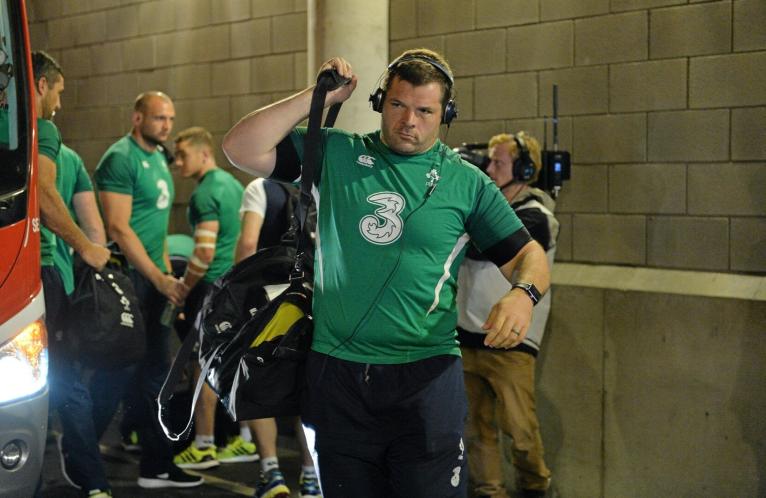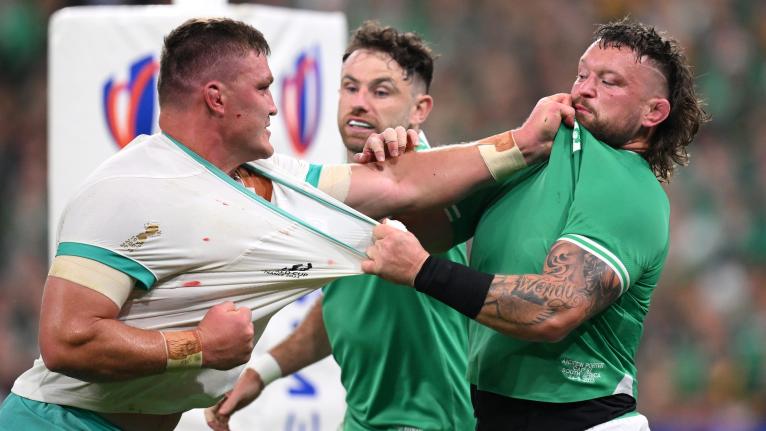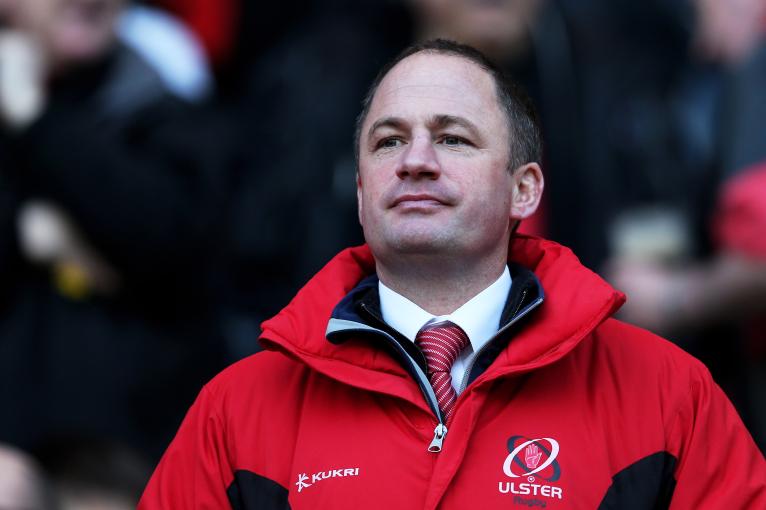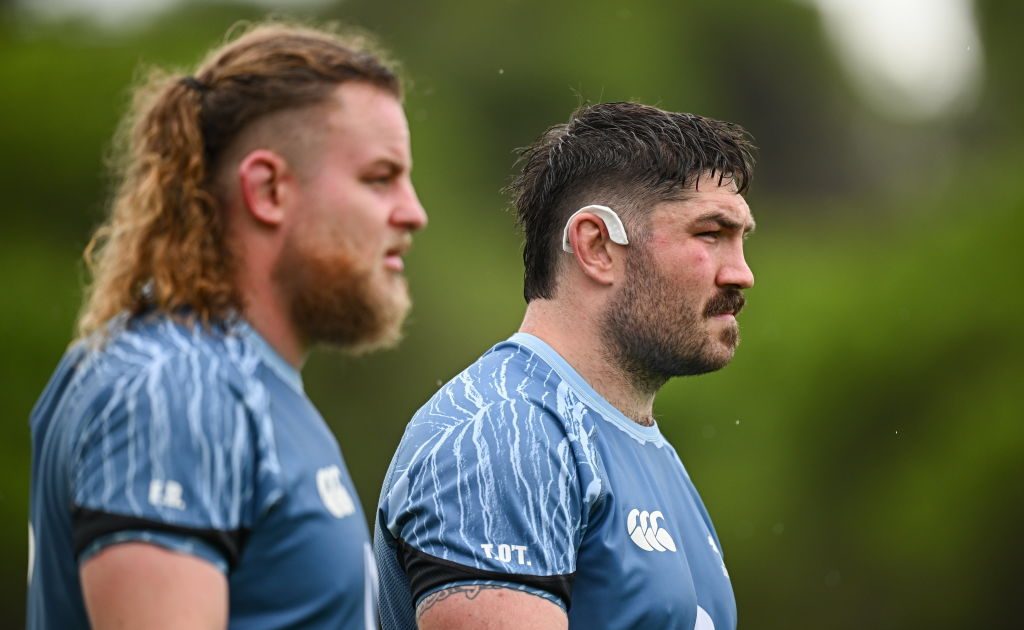Irish rugby's perennial problem has returned to haunt them

A perennial problem for Irish rugby is once again rearing its ugly head.
Ireland have enjoyed an unprecedented level of success in recent years, yet beneath the surface lurks a boomeranging challenge that threatens to destabilise their bid to remain at rugby union’s top table: the dreaded P word.
Props.
Few issues are more pressing. Last Saturday night’s 23-13 loss to New Zealand may not have ultimately come down to the setpiece, but the news that Tadhg Furlong was unavailable a few days earlier will have set off a silent alarm in Irish rugby circles. Now [Monday] it has been confirmed that third-choice tighthead Tom O’Toole will not be available due to a failed HIA suffered at the Aviva against Scott Robertson’s side.
Yet more alarm bells as Ireland’s paper-thin depth at tighthead begins to fray at the edge once more.
So much is resting on the ageing shoulders of Furlong. But that’s only half the story, as the 31-year-old’s form in the scrum has been creaking for some time.
For nearly a decade, Furlong has exemplified the modern prop. Beyond his technical acumen in the scrum, his athleticism and ball-handling have helped redefine the parameters of the position. For a time the Wexford man would be the first name pencilled in at No.3 in most World XV selections.
Yet, whisper it, he is yet to fully recapture his scrummaging form since his return from a calf injury in 2023. The brute fact is that Ireland and Leinster’s set-piece has increasingly lost its mooring under Furlong, previously one of the steadiest tightheads in world rugby. The 31-year-old is less often to be found dominating these days than he is to be found in survival mode. But he’s the best Ireland have got – by a long shot.
And with Connacht’s Finlay Bealham, who is two years Furlong’s senior, as his understudy, Ireland’s prospects for tighthead succession remain precarious.
Australian-born and reared Bealham has had his moments at the top level, but his age and a few notable struggles on the international stage would point to him clearly not being the long-term solution Ireland needs. His scrummaging this past summer against South Africa, where he faced a torrid time against the Springbok front row, didn’t make for comfortable viewing.
At 33, Bealham’s is a stopgap in Furlong’s absence, not a solution.
Ireland’s difficulty in developing front-row talent is hardly new. Longstanding would be a more accurate adjective.
Unlike in the amateur era where the likes of Ginger McLoughlin, Phil Orr and Nick Popplewell had made the front row an area of strength for Ireland, professionalism has been a far more problematic affair for the Irish propping community.
The mighty John Hayes [and to a lesser extent Reggie Corrigan] provided some measure of stability for what seemed like an age – the Bruff man won 105 caps for Ireland over 11 years. Yet even Hayes was a living embodiment of Ireland’s front-row malaise: a 6’4, 20-stone physical freak from a GAA background who only happened upon rugby in his late teens and started life in the second-row. Hayes’ value to Irish rugby at the time is hard to overstate but – in truth – his scrummaging ability is often viewed through the myopic lens of nostalgia. He rarely dominated his opponents and most of the time Irish rugby supporters were left praying he didn’t go backwards.

The even larger Tony Buckley, Rodney Ah You and Aussie loosehead import Tom Court – an exceptional junior shotputter for Australia – were very much in that tradition: big, strong athletes who struggled to master the dark arts at the highest level.
And who could forget Michael Bent, who was parachuted in the Ireland squad from New Zealand at short notice following an injury panic back in 2012.
Too often Ireland’s tightheads have felt that they’ve fallen into the sport’s lap, the product of luck rather than design.
Indeed, the journey of arguably Ireland’s best scrummaging tighthead of the past two decades, Mike Ross, underlines the failure of the Irish pathway system to identify propping talent. Ross was released by Munster and only returned to prominence after proving himself in the English Premiership with Harlequins. His re-entry into the Irish fold came as a godsend at the time, yet it raises the obvious question: why was the 124kg tighthead let slip through the net in the first place?

Similar questions could be asked about Oli Jager (and for that matter loosehead James Cronin, who is playing his trade at Leicester Tigers). Like Ross before him, Jager left Ireland to establish his credentials with the Crusaders before returning to sign with Munster.
Developing tightheads overseas that qualify for Ireland isn’t necessarily a bad thing, even if Jager was – for a time at least – on the All Blacks‘ selection radar. The argument could be made that Irish-qualified props getting game time overseas is a feature rather than a glitch in the current system.
Ulster’s Corrie Barrett is an example of another potential prop talent developed overseas after leaving Ireland. He signed to the northern province as injury cover after successful stints with both the Bedford Blues and Doncaster Knights in the English second-flight RFU Championship.
Meanwhile, the likes of homegrown talent O’Toole offer some hope, albeit tempered by frequent injuries. The Ulster prop has shown promise but remains untested at the highest levels over extended periods. Farrell’s selection of O’Toole as loosehead cover over the summer certainly raised eyebrows. Of the Drogheda-born prop’s 56 professional appearances, a big fat zero have come at loosehead.
Fellow Leinster product Jack Aungier (25) is building out a name for himself in Connacht and featured in the recent Emerging Ireland tour, as did Ulster’s Scott Wilson (22) and Munster’s Ronan Foxe (21).
A knee injury has brought the development of former American football athlete Roman Salanoa to a grinding halt. The 123kg former linesman hasn’t played for Munster since May of 2023. Teammate and fellow rookie Mark Donnelly (23) is possibly the major beneficiary of Salanoa’s injury woes.
The loosehead situation is in better health admittedly, but only just. Andrew Porter has become an all-court prop that can scrummage effectively and tear it up in the loose. The 28-year-old is challenging – if not now eclipsing – Furlong as Ireland’s MVP [most valuable prop]. It is also not inconceivable that Porter will [once again] make the transition across the front-row to tighthead and become a long-term solution to a post-Furlong front row.

At Test level there still remains a troubling reliance on ageing talent, however. Cian Healy, now 37, remains the primary alternative to Andrew Porter in the Irish squad in the absence of Dave Kilcoyne, who at 35 is no spring chicken himself. While Healy’s longevity is commendable, his continued presence in the national setup speaks volumes. The expectation for Healy to continue providing stability speaks to the scarcity of trusted front-row players within the current setup.
Munster’s Jeremy Loughman has shown he can do a job when called upon, although he notably didn’t make the cut for the November squad, with Farrell taking just two looseheads among his five props. Nor did tighthead teammates Stephen Archer (36), John Ryan (36), young gun Josh Wycherley (25) and the aforementioned Jager, who has a neck injury.
Still, Leinster’s young academy props also offer glimmers of potential, though they must be afforded the space and time to mature without undue pressure. As well as his five established props for this Autumn Nations Series, Farrell brought Leinster tighthead Thomas Clarkson (24) and loosehead Jack Boyle (22) into camp as part of his ‘training panellists’. Clarkson has already amassed 49 appearances for Leinster, 21 coming as a starter. Boyle has won 13 caps, starting seven of those games.
Should Furlong not recover in time for Argentina, then Clarkson will be named on the bench behind Bealham for this Friday night’s showdown with Argentina, who apparently like a scrum or two.
Loosehead Michael Milne (24) is also impressive at Leinster and has moonlighted at tighthead on at least two occasions. He has 46 appearances for Leinster, albeit only 12 as a starter.
Fellow Leinster loosehead Leinster Alex Usanov featured in the Emerging Ireland tour, though at just 19 is very much in his development infancy; as is Paddy McCarthy’s (21). The compact 110kg front-rower has split his Leinster caps between both tight and loosehead positions.
Ulster’s Eric O’Sullivan (28) is also part of the picture and will be eager to avoid becoming a one-cap wonder having made his debut against Scotland back in 2020. Teammate Callum Reid (25) will also eager to make a case for himself, as he competes for game time in Belfast. The departure of Steven Kitshoff will certainly make that easier.

The Test ship may have already sailed for the likes of Connacht veteran Denis Buckley (34), Ulster’s Andy Warwick (33) and converted back-row Peter Dooley (30).
To credit the IRFU, the prop problem is one that they actively attempting to fix, even if, like the Irish healthcare system, it proves a tricky nut to crack.
Indeed it’s a challenge that David Humphreys, who succeeded David Nucifora as the IRFU’s performance director, is confronting head-on. This summer Humphreys announced a strategic moratorium on the recruitment of foreign front-rowers, effective from next season. It was badly needed.
“Since forever, since the game’s been professional, there’s been questions over how we’re going to replace John Hayes,” said Humphreys in July. “They [the provinces] need to find ways to bring props through their system to ensure that they are competitive, both now, and as they need to replace some of the more senior players coming through.”

It’s a clear bid to force the Irish provinces to cultivate a homegrown pipeline of front-row talent. Leinster’s summer signing of French tighthead Rabah Slimani – who replaced Samoa’s Michael Alaalatoa – could well be among the last foreign recruitments of its kind in the position.
The stakes are clear: Ireland’s scrummaging future is being transferred, by necessity, to domestic talent. This change, of course, places a new level of accountability on the provinces. For decades, the nation has relied on a relatively limited pool of players, which is a structural challenge as much as it is a matter of talent.
But the current Irish model, thanks in part to Leinster’s remarkably hyperactive pathway system – is renowned for talent ID and development, so why can’t this be true for props as well?
Theoretically at least and notwithstanding injuries, under Humphreys’ new protocols there should be at least eight looseheads and eight tightheads across the four provinces that are getting significant gametime for their provinces’ between international, European and league competitions; with no Slimanis or Alaalatoas hogging game time and stalling development.
It makes sense.
Yet, even with Humphreys’ new directive, the challenges in Ireland’s rugby system are unlikely to disappear overnight. The process of nurturing props – tighthead props in particular – from junior levels up through the ranks is notoriously slow. Unlike more versatile positions, front-row players require years of dedicated training to build the strength, technique, and resilience needed to withstand the physical toll of international rugby scrummaging. That requisite skill set is often built through gradual exposure and consistent game time against elite opposition.
In the short term, however, Irish rugby will have to continue walking a tightrope.











































































